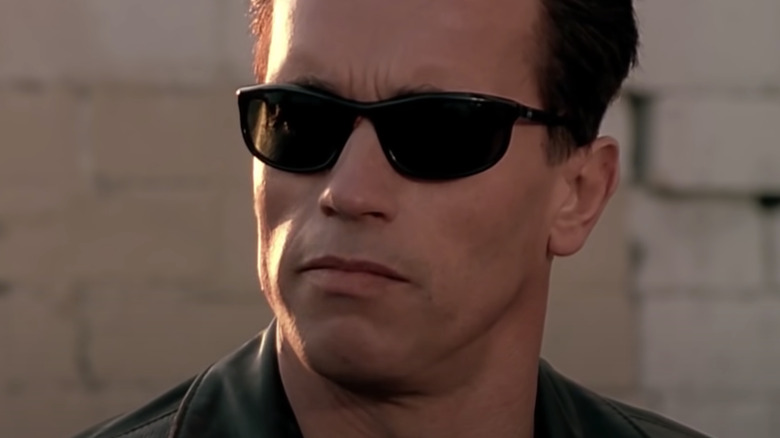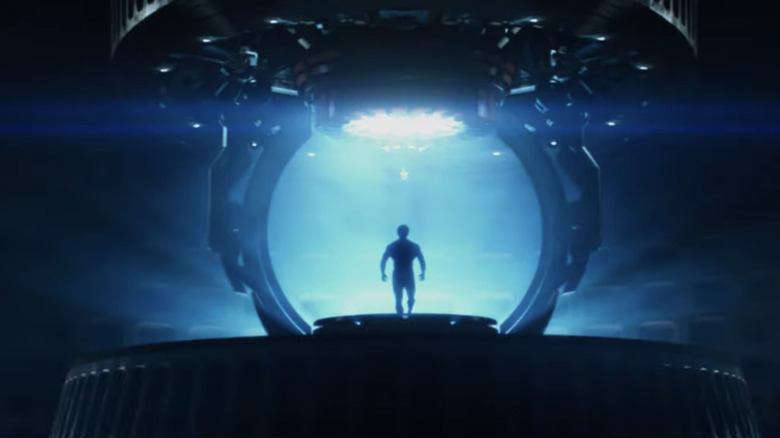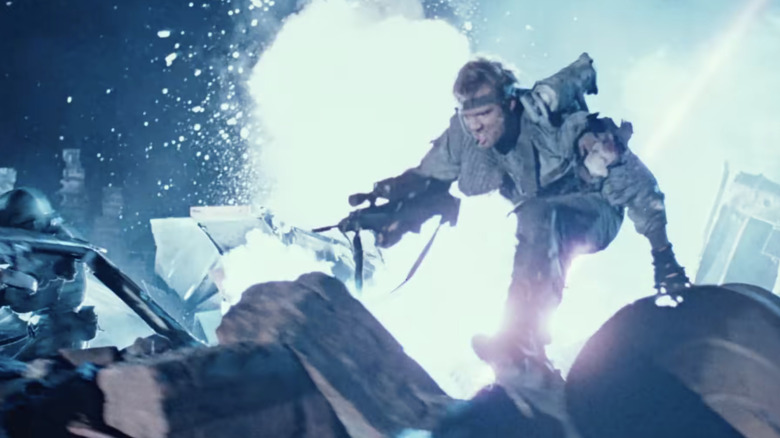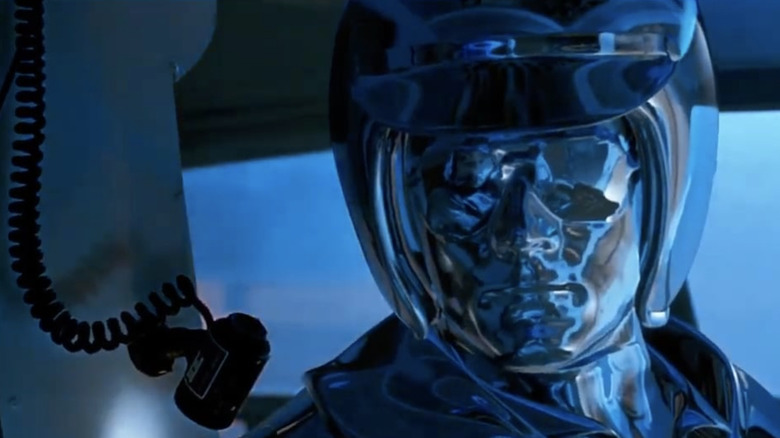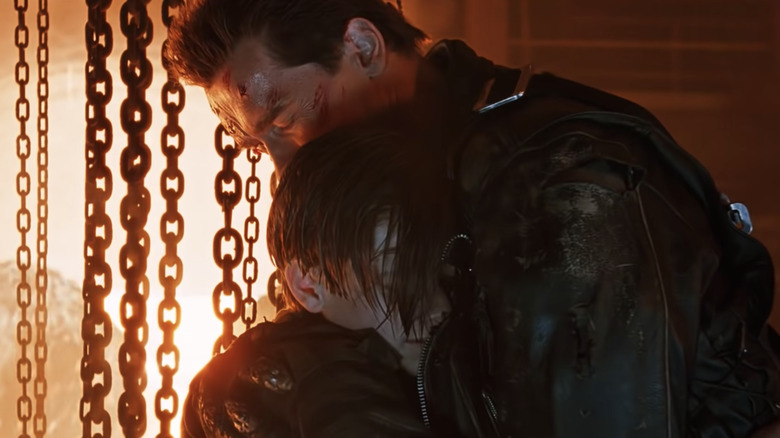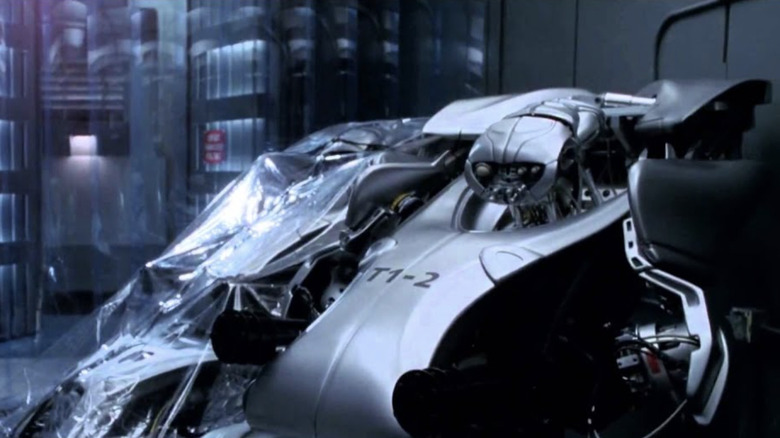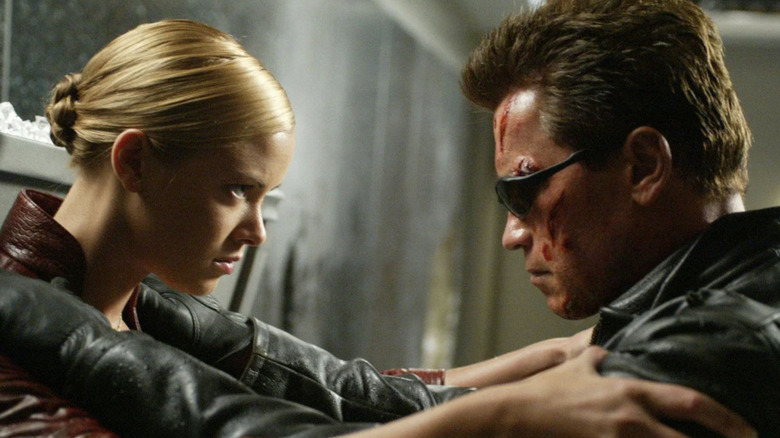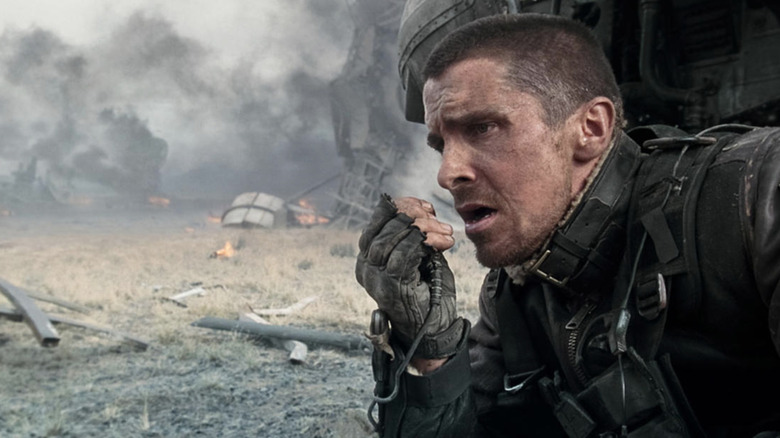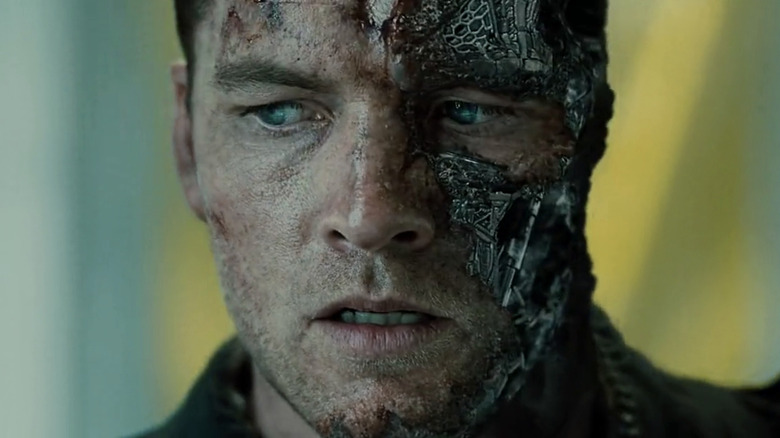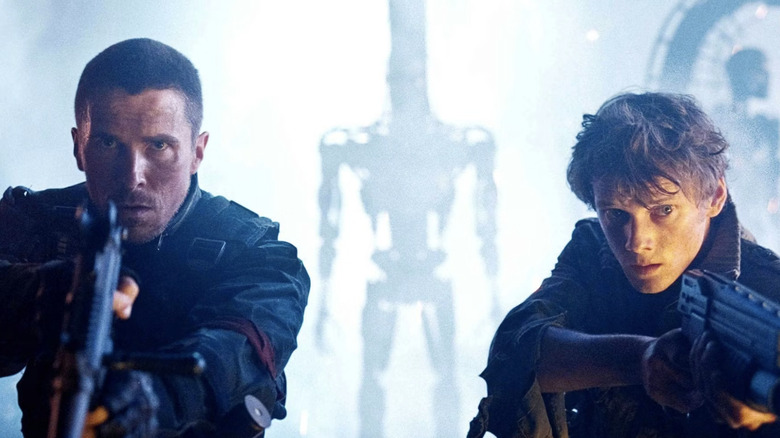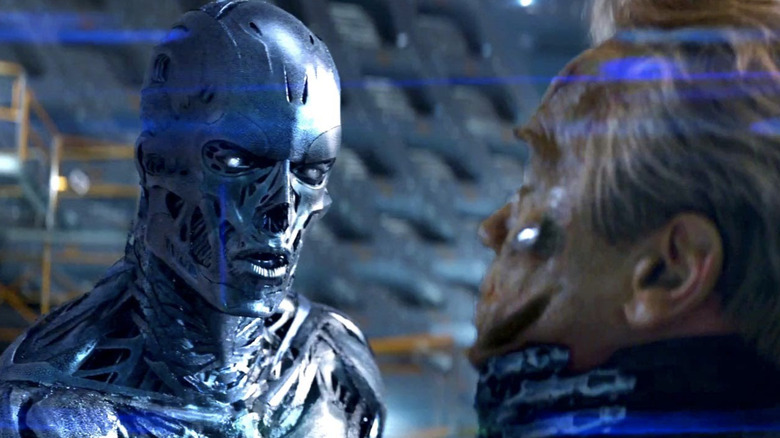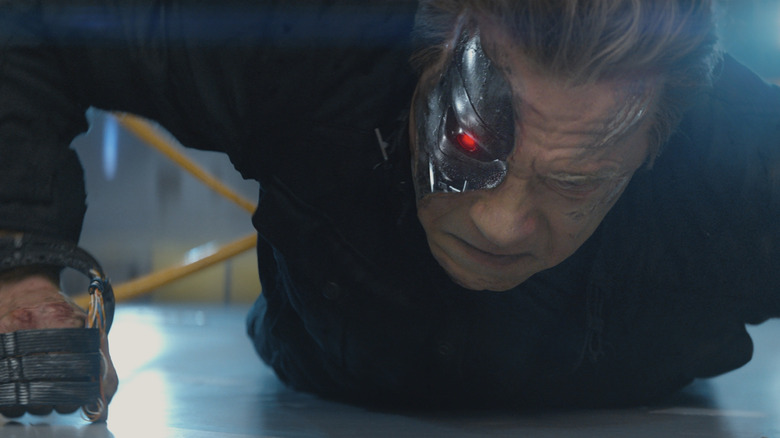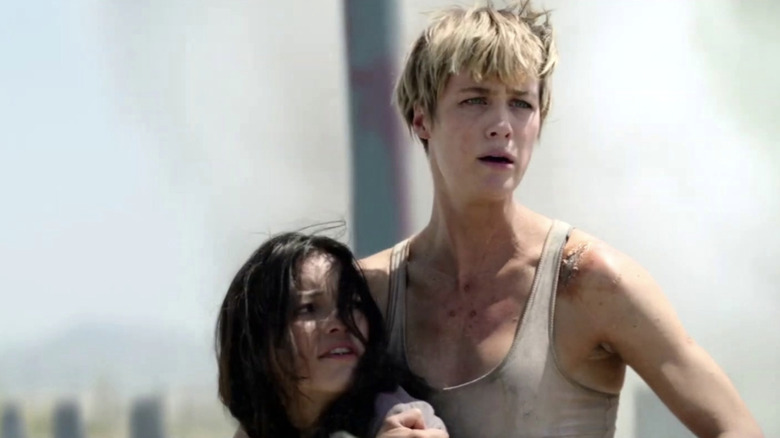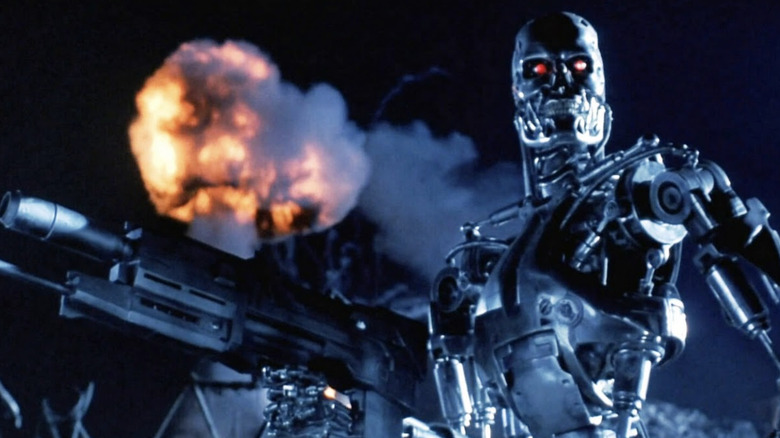The Terminator Franchise's Most Confusing Moments Explained
With his trademark sunglasses and leather jacket, Arnold Schwarzenegger's Terminator is one of the most recognizable movie icons ever. Classic catchphrases such as, "I'll be back," "hasta la vista, baby," and "come with me if you want to live" are often attributed to the "Terminator 2: Judgment Day" action hero, making him an important part of the zeitgeist. And yes, we know two of those lines were first uttered by Edward Furlong's John Connor and Michael Biehn's Kyle Reese, respectively, but Arnold made them sound even cooler.
Though it's one of the greatest science-fiction franchises of all time, the "Terminator" series can get a bit confusing. Among multiple timelines, various reboots, and the discrepancies between the films and the television series "Terminator: The Sarah Connor Chronicles," there are many things throughout the franchise that get a bit strange. Thankfully, the most confusing moments in the series tend to be explained by the films and shows themselves, even if said explanations get buried by intense action sequences or time travel-y retcons. There is "no fate" after all. Or is there?
So don your leather jackets, rev up your motorcycles, and remember that machines, not human beings, are your enemy, because we're about to explain some of the most confusing moments of all of the "Terminator" franchise. From the original James Cameron films all the way through to the conflicted 2019 "requel" "Terminator: Dark Fate" and the Lena Headey-led series "Terminator: The Sarah Connor Chronicles," we're covering it all.
The mechanics of time travel
In "The Terminator" and its sequels, a fighter from the future and a Terminator each arrive in the past through a silver-ish sphere that gives off electrical output. Nothing inorganic will go through, which is why a Terminator must have living human tissue to cover its metal endoskeleton. It's also why Kyle Reese arrives naked in 1984 and can't bring anything back from the future with him. This remains mostly consistent throughout the franchise, even if James Cameron's non-canon "T2: Battle Across Time" theme park attraction briefly changed the rules.
From what we know from the films, Skynet creates time travel as a means to ensure its own survival and kill its enemies before they're born. This is why the T-800 is sent to 1984 to kill Sarah Connor (Linda Hamilton) in "The Terminator" and why the T-1000 is sent to 1995 for John in "Terminator 2." Time travel is achieved in the "Terminator" universe through a device called a TDE — which stands for Time-Displacement Equipment — and evidently, Skynet built more than one, since there are multiple timelines and sequels.
Sometimes time travel goes wrong. The reliability of time-jumping is questioned in the "Terminator: The Sarah Connor Chronicles" episode "Self Made Man," when a T-888 is accidentally sent back to 1920 instead of 2010. Interestingly, the series also confirms that Time-Displacement Equipment can not only send one backward in time, but forward too — a trick that would be used again in "Terminator Genisys."
Sending only one Resistance fighter back in time
Over the years, many have wondered why only one Resistance fighter was sent back in time in the original "Terminator" and not two. Well, although older drafts of James Cameron's script included a second fighter alongside Kyle Reese — one who died unexpectedly due to a time-traveling error — the final film only showed Kyle go through. While the reason for sending Kyle back is obvious, the reason John Connor didn't send another human fighter with him is less so.
In the "Terminator" universe, Time-Displacement Equipment is still highly experimental. Skynet had only recently developed the technology before Connor's Tech-Com unit captured Skynet's central core in 2029. John could barely risk sending Kyle back, let alone another human being, and thus beginning in "Terminator 2," John sent reprogrammed Terminator units back in time to stop Skynet's forces. In the "Terminator: The Sarah Connor Chronicles" episode "Today Is The Day, Part 2," a teenage John Connor further notes that the reason the future him probably stopped sending more humans back in time was that, unlike machines, human lives couldn't be replaced.
Though the films usually only feature one Resistance fighter from the future, the show changed the game as John's Resistance developed TDE of their own, even sending engineers back in time to build time machines in the past to support more Resistance fighters who'd arrive to stop Skynet's initial development. Naturally, they were hoping to end the Future War before it started.
Is Kyle Reese always John Connor's father?
One of the biggest paradoxes in all of cinema is the grandfather paradox in "The Terminator." If John Connor knew that Kyle Reese was his father, the question is, was Kyle always John's father? While there's no direct in-universe answer to this question, the easiest explanation is that the timeline that Kyle Reese hails from in "The Terminator" has already been changed by a previous Kyle Reese, one whose timeline, and John Connor, is no more.
This means that in the first timeline, referred to by fans as the Alpha timeline, Kyle Reese is sent back in time by the original John Connor to protect Sarah, only to fall in love with her. Because of this, Kyle inadvertently changes the timeline by fathering her child, thus creating the 2029 future from "The Terminator." This child is not the same John Connor from the Alpha timeline, though Sarah would name him John anyway because of Kyle's stories of the future.
This John Connor experiences Judgment Day like everyone else, though he remembers Sarah's stories of Kyle Reese. Knowing that Kyle is his father — even though Kyle wasn't the original John Connor's father — this new John becomes the same future Resistance leader John Connor that we know from the movies and "The Sarah Connor Chronicles" series. As a result, John sends Kyle back to 1984, as seen in the first film, to ensure both his own survival and now also his conception.
The T-1000's abilities and weaknesses
Early on in "Terminator 2," the T-800 explains to John Connor that the liquid metal Terminator, known as the T-1000 (Robert Patrick), can only take the form of people it touches. Likewise, the T-1000 can only take the shape of something of equal mass, meaning that it can't turn into anything with moving parts. Yet when the T-1000 infiltrates the Pescadero State Hospital to retrieve Sarah Connor, it disguises itself as the floor.
In what seems like a contradiction, this can be explained as a simple camouflage technique, different from its complex ability to mimic human tissue and not unlike its ability to turn its arms into blades. The T-1000's floor disguise is a simple metamorphosis that doesn't require as much complexity in shifting. It's also worth noting that, when piloting a helicopter, the T-1000 can even grow extra arms to better multitask, meaning we might not know everything this machine can do.
But the T-1000 has a weakness too, as seen near the end of "T2" when it begins to melt in the intense heat of the steel mill. Though it initially seems to be a huge design flaw on Skynet's part, the truth is that the T-1000 was previously damaged by Arnold Schwarzenegger's action hero after it had been frozen. Because of the intense temperature changes from extreme cold to extreme heat, the T-1000 struggles to hold a solid form in the steel mill and thus is easier to defeat than before.
The Terminator's advanced learning capabilities
Speaking of the Terminator's capabilities, it's explained in "Terminator 2" that once the reprogrammed T-800's switch has been flipped on its CPU, the Terminator can learn like any other advanced artificial intelligence. While the scene isn't included in the theatrical cut of the film, the special edition of "T2" shows Sarah and John performing surgery on the Terminator, giving it the ability to better learn and explaining why the T-800 begins to adapt John's catchphrases as his own.
In addition to the T-800, other advanced models seem to possess some learning capabilities too, namely the T-1000, as seen when it tortures Sarah at the end of "T2." Instead of killing Sarah and mimicking her to lure in John, he opts to torture her instead, giving her time until the T-800 intervenes. It's possible that, like how the T-800 cares for John by the film's end, the T-1000 learned to enjoy the thrill of the hunt. Even if it cannot show other emotions, it seems to enjoy inflicting pain — it's in its programming after all.
Other Terminators like the T-X (Kristanna Loken) in "Terminator 3: Rise of the Machines," the T-888's and T-900 (Summer Glau) in "Terminator: The Sarah Connor Chronicles," and the Rev-9 (Gabriel Luna) in "Terminator: Dark Fate" all seem to have some sort of learning abilities as well, which range and vary depending on their mission parameters and their loyalty to Skynet — or whoever else may have sent them.
Sarah Connor makes the same mistake twice
In "The Terminator," Sarah Connor runs for her life after the villainous T-800 arrives in 1984 to kill her, and by extension her future son. Aided by Kyle Reese, Sarah makes it out alive by crushing the skinless Terminator in a hydraulic press — though Kyle wasn't so lucky. Despite her victory, Sarah leaves the Terminator's body — namely it's functional arm and CPU — intact and available to be scooped up by Cyberdyne Systems, who would use it to advance their AI research and eventually create Skynet.
While it's understandable that a traumatized Sarah might not have thought that far ahead in the first Terminator, it's downright unforgivable that the battle-hardened warrior we know from "Terminator 2: Judgment Day" makes the same mistake. At the end of "T2," Sarah, John, and the T-800 drown the T-1000 in molten steel, only for the T-800 to sacrifice himself the same way to prevent Skynet's birth. Hoping to get rid of all the evidence, John throws in the old T-800's arm and chip as well. But they forgot one crucial thing.
Though they made sure that the T-800's CPU was still in its head as Sarah lowered it into the molten steel, the arm it lost in combat with the T-1000 remained stuck in the factory to be used to create Skynet again ... and if "Terminator 3" and "Terminator: Dark Fate" are to be believed, that's exactly what happened.
Somehow the army makes Skynet faster than Cyberdyne
By the end of "Terminator 3: Rise of the Machines," Skynet is activated, and within hours Judgment Day occurs. Given that Judgment Day was originally supposed to happen in 1997 with Miles Dyson's (Joe Morton) version of Skynet, it's incredible that the U.S. Army and Cyber Research Systems were able to put Skynet online in 2003 after all of Dyson's research had been, well, terminated. Yet somehow, government funding allows for this advanced drone-piloting AI to be built in less than 10 years between "T2" and "T3."
Besides the fact that Cyber Research Systems compiles whatever was left of Dyson's records at Cyberdyne, the T-800's forgotten arm from "Terminator 2" was also a launching point for Skynet. Another reason that Skynet may have been able to come online quicker in "Rise of the Machines" is that the program was completed after the widespread distribution of the world wide web. When James Cameron's first two "Terminator" features were created, the internet was not what it was in the 21st century, but in a post-9/11 world, Skynet could thrive as a software program, forever shedding the limitations of hardware.
John Connor (Nick Stahl) explains this at the end of "T3" when he says that Skynet "was software; in cyberspace. There was no system core; it could not be shut down." In the alternate timeline of "Terminator Genisys," Skynet comes online in 2017, and its connection to the internet allows it to evolve within seconds instead of hours.
The anti-Terminator Terminator
Though the T-800 infiltrators and the T-1000 prototypes were both effective, Skynet develops newer and deadlier models of Terminators in the future. Unlike the hulking T-800 or even the sleek T-1000, the T-X of "Terminator 3" combines the best parts of both models while adding some new weaponry in the process. With both an endoskeleton base and a mimetic polyalloy flesh covering, the T-X is a near-perfect infiltrator, one that could terminate a Terminator just as easily as a human being. But why would Skynet want to create a Terminator meant to take out other Terminator units?
While humanity still posed a threat to Skynet in the future, not to mention the past, the T-X was initially produced as what John Connor would call an "anti-Terminator Terminator." As Skynet learns that the Resistance has been repurposing its own T-800 series infiltrator units, the AI decided that it needed a Terminator that could fight against its own reprogrammed kind if need be. Thus, the T-X is born as a combination of the greatest models to date.
With over 80 kills in "Terminator 3" alone, the T-X proves to be one of the most formidable Terminators. It's even able to hijack other machines, including Arnold Schwarzenegger's new T-850, and reprogram them to suit its needs. In fact, it nearly gets the T-850 to kill John Connor. As one of Skynet's best weapons, the T-X is a resourceful and innovative Terminator that we've sadly not seen much of since 2003.
Fighting Skynet in broad daylight
In the first three "Terminator" films, each of the Future War sequences take place in the dead of night. Though Terminators can still see at nighttime, the Resistance's activities are a bit harder to make out under the cover of darkness. Yet the McG-directed "Terminator Salvation" shakes things up a bit. Taking place almost exclusively in a post-apocalyptic 2018, the events of "Salvation" strangely occur in broad daylight as Marcus Wright (Sam Worthington) wanders through a post-Judgment Day world, which seems like a massive flaw.
While the film has often been criticized for not looking much like the Future War we'd been promised before, it's worth noting that much of the film still takes place at night. Regardless, Marcus is new to this Terminator-infested wasteland, making his daytime travels understandable by ignorance. Beyond that, the Future War we're used to seeing usually takes place near the end of the conflict in 2029, while "Terminator Salvation" only takes place in 2018 — 15 years after "Terminator 3: Rise of the Machines."
It stands to reason that over time John Connor (Christian Bale) and the Resistance would continue to shift their tactics and begin to attack Skynet more under the cover of darkness. Given that both Skynet and the Resistance have yet to develop plasma-based weapons in 2018, not to mention time travel, it makes sense that these earlier years of the Future War would look different than the end of it. They still had lots to learn.
Is Marcus the only Hybrid Skynet made?
Another revelation that comes out of "Terminator Salvation" is the idea that cyborgs can be made one of two ways. While the T-800 infiltrators are machines with human skin, Marcus Wright is a man who was turned into a machine. Not unlike Cyborg from DC Comics, many of Marcus' internal organs are swapped out by Skynet's lackeys in favor of mechanical parts, though others such as his heart and brain remain intact.
Over the course of the film, Marcus discovers what's been done to him and resists Skynet's influence over his mind, proving that he's still in fact more man than machine. But the question remains: Is Marcus the only hybrid? According to some of the "Terminator" novels and comic books — including "Terminator Salvation: The Finale Battle," which rounded out the "Salvation" timeline — there were other successful hybrids that came out of Project Angel. Had the "Terminator" series not been rebooted after "Salvation," these plot threads may have continued on screen.
The idea of human/machine hybrids would be revisited again in "Terminator: Dark Fate." Future warrior Grace Harper (Mackenzie Davis) is turned into an enhanced human called an Augment, this time by her future's Resistance rather than an evil AI. Though her body is cybernetically reinforced, Grace is still human. This process takes its toll, however, forcing Grace to take a specific concoction of drugs whenever she's "overheated." As it turns out, turning people into machines might not be the best idea.
Skynet knows too much about John Connor
As more and more "Terminator" sequels were released, Skynet seemed to gain more of an upper hand. In "Terminator Salvation," Skynet learns that Kyle Reese (Anton Yelchin) is John Connor's father, a fact that only John, his wife Kate (Bryce Dallas Howard), and a deceased Sarah Connor ever knew. But this is never explained. How does Skynet, an artificial intelligence, know all of this about John Connor? After the timeline is changed by the events of "Terminator 2," Skynet goes from being hardware to software, and while this change may not seem significant, it might be the key to understanding Skynet's newfound intelligence.
Skynet's internet presence would give it access to unlimited information. Besides nuclear launch codes and personal emails, this could even extend to Sarah Connor's patient files from the Pescadero State Hospital if they were ever digitized. Assuming they were, it's plausible that Skynet learns about John's parentage based solely on Sarah's out-of-control ramblings, especially if the AI had also infiltrated the human Resistance and learned of a young up-and-comer named John Connor. Naturally, Skynet would've put two and two together.
While this is never explained on screen, it's the only explanation that makes sense given that Skynet shouldn't know that John Connor and Kyle Reese are related at all. While the "Terminator Salvation" timeline never had the chance to expand on his apparent plot hole, Skynet's status as an internet infiltrator seems to put some of the pieces back together.
The death of John Connor
The last two "Terminator" reboots were met with mixed reactions. "Terminator Genisys" and "Terminator: Dark Fate" each took the franchise in different directions, hoping to tell a new story with familiar faces. While there were certainly redeeming moments in both, possibly the most hated changes involving killing John Connor. While "Dark Fate" kills a young John outright, in the most brutal and unforgiving way possible, "Genisys" does it a bit differently.
The opening sequence ends as John (Jason Clarke) sends Kyle Reese (Jai Courtney) back in time to the events of "The Terminator." In fact, many of the moments in "Genisys" are shot-for-shot remakes of the original 1984 film. But things change when the T-5000 (Matt Smith), the physical embodiment of Skynet, attacks John and rewrites his DNA with nanites. Later, John arrives in the past to reunite with Kyle and Sarah (Emilia Clarke), but he's not exactly himself. Instead of flesh and blood, John is now a machine, a new brand of Terminator called a T-3000.
But while the machine calls himself John Connor, no different than he was before, it's a lie. Despite the claims that he's the same man only turned machine — much like Marcus Wright — this John Connor has been rewritten on a genetic level, meaning that John Connor has died and been replaced. The T-3000 is no more John Connor than the T-1000 was Sarah Connor at the end of "Terminator 2," the only difference is that this machine tragically thinks he's still the man.
The origin of the Pops Terminator
"Terminator Genisys" introduces another peculiar character, an aged T-800 (Arnold Schwarzenegger) who raised Sarah Connor (Willa Taylor as a kid, Clarke as an adult) – who affectionately calls him "Pops" — to become a warrior. In this timeline, the Pops Terminator arrives in 1973 to save a young Sarah from a T-1000 after her parents were murdered. From then on, he raises her as a warrior, preparing her for her future with Kyle Reese and her role as the mother to John Connor, but it isn't explained where Pops came from.
Unfortunately, John didn't have time to send Pops back before Skynet's attack, making the identity behind his senders a well-kept secret. In fact, Pops notes that he doesn't know who reprogramed him, since those files were intentionally erased. Though a trilogy and a spin-off television series surrounding "Genisys" were planned, these projects were abandoned after the film failed to meet commercial expectations, meaning that any direct answers will likely never be explored.
Despite that, it's highly probable that Pops was sent back in time to preserve Sarah Connor either by a later faction of the human Resistance or possibly even Skynet itself. While it might seem crazy, it's possible that Skynet — from further on in the timeline — sent Pops back to the 1970s to protect Sarah Connor from a younger version of itself, hoping to ensure that its plan to transform John into the T-3000 would still occur in 2029. Maybe that's a stretch, but it'd certainly be a twist worth exploring.
Grace's relationship with Dani Ramos
In "Terminator: Dark Fate," a new timeline is created after Sarah, John, and the "Uncle Bob" Terminator from "Terminator 2" changed the future, stopping Skynet. Unfortunately, though the future was rewritten, a new AI named Legion rises to power, enacting its own Judgment Day. With no John Connor to lead humanity, a woman named Dani Ramos (Natalia Reyes) becomes the face of the human Resistance. But to protect her from Legion's time-traveling assassin, an augmented warrior named Grace Harper traveled through time.
Throughout the film, Grace is incredibly protective of Dani, to the point of not trusting Sarah Connor — an expert who had been in Dani's shoes before. Unlike the relationship between Sarah and her protector Kyle Reese, the love between Grace and Dani, which may seem romantic at first, isn't actually romantic at all; it's familial. Although Grace isn't Dani's flesh and blood, she was raised by the future Resistance leader as if she were her own daughter after Dani saved a young Grace (Stephanie Gil) from a group of human survivors.
Although Dani didn't want to send Grace back in time, her surrogate daughter insisted, undergoing the Augment procedure and traveling back 20 years to save Dani from Legion's Rev-9 Terminator. After sacrificing herself in 2020, Grace dies fending off the Rev-9, helping an older T-800 defeat the new Terminator. At the end of "Dark Fate," Dani and Sarah look after a younger Grace from afar, resolving to protect her should another Terminator arrive.
Mission complete, now what?
The opening of "Terminator: Dark Fate" was shocking for everyone. After the newest installment erased everything from the canon but the original James Cameron films, "Dark Fate" went an extra step further and blew John Connor away. After a new T-800 killed John, the machine wandered aimlessly, its mission finally complete. Yet instead of shutting down, the cyborg settles down, has a family, and opens a drapery business under the name "Carl."
In one of the strangest twists to come from the "Terminator" series, Carl spent his days hoping to atone for his mistakes. Somehow, this Terminator became self-aware enough to learn, adapt, and nearly feel some human emotion. For years, Carl uses his knowledge of the future to send Sarah the coordinates of Terminators that Skynet previously sent back in time before that future was erased. This allows Sarah's life to continue to have meaning and helps Carl atone for his mistake.
Unlike the T-800 from "T2," which needed a switch on his CPU to be flipped, Carl develops his personality on his own. It seems that this may have been a feature that Skynet gave to its time-traveling Terminators, that once their mission was complete, they could choose their own path. In fact, it's possible that we even see this at the end of "T2" when the Terminator tells John, "I know now why you cry." The T-800 only says that after his mission to defeat the T-1000 has been completed.
Cameron is a unique model of Terminator, except when she isn't
In "Terminator: The Sarah Connor Chronicles," the T-900 model named Cameron arrives in 1997 to help John (Thomas Dekker) and Sarah battle yet another Terminator, this one a T-888 called Cromartie (Garret Dillahunt). As Cameron aids Sarah and John in their mission to stop Judgment Day, she reveals that she's not like all the other Terminators. For instance, Cameron can eat, cry, and apparently even express and feel human emotion. Admittedly, that last one is questionable, but she can do the rest!
Another way that Cameron appears different is the color of her eyes. While most Terminator models – barring the T-X from "Terminator 3," though that takes place in another timeline — have distinct red eyes, when Cameron flashes hers, they're blue. However, in the series finale "Born to Run," half of Cameron's skin is blown off, revealing her red-eyed endoskeleton underneath. Unfortunately, "The Sarah Connor Chronicles" was canceled before we could get any on-screen answers.
Thankfully, series creator Josh Friedman — who would later work with James Cameron on "Terminator: Dark Fate" and "Avatar: The Way of Water" — confirmed that this is not an error. "It's red because at the core she's a Terminator," he explained. "I made it blue in the pilot to indicate she was different but that wasn't to suggest the hardware was blue" (via Save TSCC). Turns out, Cameron's not so different than other Terminators on the inside.
The mysterious three dots
One of the most frustrating plotlines on "Terminator: The Sarah Connor Chronicles" was the three-dots arc in the middle of the show's second season. While "The Sarah Connor Chronicles" was usually a hit when it came to character arcs, this one might've dragged on a bit too long. At the beginning of Season 2, a dying Resistance fighter named Wells (Zack Ward) wrote a bunch of names, dates, and locations in blood on the Connors' basement wall — including three mysterious dots.
Sure that they have something to do with Skynet, Sarah investigates them further after beginning to dream about them and see them everywhere. Though Sarah looks into a tech firm and government stealth drones, nothing seems to fit the bill. Eventually, she's forced to drop the whole thing after she nearly dies and hallucinates Kyle Reese (Jonathan Jackson). At times, we're left to wonder if it wasn't all just in Sarah's head all along.
While there are plenty of things this symbol could've represented, it's implied in "Born to Run" that the three dots directly refer to the Turk — a chess program used to create the artificial intelligence named John Henry (Dillahunt). Though the Turk was originally supposed to have been a precursor to Skynet, due to interference by Sarah and Derek Reese (Brian Austin Green) it instead contributes to the creation of a rival AI, one who learns morals and ethics. In fact, it's further implied that John Henry might one day help John Connor combat Skynet in the future.
All the complicated timelines
With six films and a television series, there are plenty of timelines in the "Terminator" franchise, and sometimes it's hard to keep them all straight. The original classics — both James Cameron films, "The Terminator" and "Terminator 2: Judgment Day" — exist in the same timeline and are the basis for every deviation afterward. This is the timeline in which Kyle Reese travels through time, saves Sarah Connor, and fathers John Connor, and years later, Sarah, John, and a reprogrammed Terminator fight the T-1000 to stop Judgment Day.
From there, the timelines split depending on what you're watching. "Terminator 3: Rise of the Machines" follows "T2" and ends with Judgment Day occurring in 2003, which sparks the post-apocalyptic world of "Terminator Salvation." Simultaneously, the television series "Terminator: The Sarah Connor Chronicles" skips over the events of "T3" and "Salvation," instead only counting the first two James Cameron films as canon to its timeline.
"Terminator Genisys," on the other hand, reboots the franchise completely. Though it starts off in the world of the 1984 film, both Skynet and John Connor change the timeline, with Sarah Connor and Kyle Reese ending up in 2017 to prevent Judgment Day. Lastly, 2019's "Terminator: Dark Fate," takes place in a world where only the events of the first two "Terminator" films occurred. In the wake of John's death, an older Sarah Connor teams up with an old T-800 and a warrior from the future to protect the next leader of the human Resistance.
No fate but what we make, or is there?
One of the recurring themes in the "Terminator" franchise is the idea of fate. In the first "Terminator," Kyle relays a message to Sarah Connor from her future son, a message that includes the line, "There is no fate." This line is expanded in "Terminator 2" as "There is no fate but what we make for ourselves," which is echoed in just about every "Terminator" film, series, video game, or comic book following. This idea that the timeline can be changed, that destiny can be averted, is what leads Skynet and the Resistance to send fighters into the past to change the future.
Except, despite the attempts to change the world, nearly every "Terminator" film also confirms the idea that fate is very real. While John and Sarah change the future in "T2," it only delays the inevitable. In "Terminator 3: Rise of the Machines," "Terminator: The Sarah Connor Chronicles," and "Terminator: Dark Fate," which all follow the events of "T2," destiny hasn't been changed or thwarted, it's only been postponed. Judgment Day still happens, humanity is still nearly wiped out, and Terminators still travel back in time to wipe out the future leader of the human Resistance.
While the "Terminator" franchise proves that the future is fluid and can change, it also proves that destiny will be fulfilled. Even "Terminator Genisys," which ends with Sarah, Kyle, and a new T-800 accomplishing their mission, ends with Skynet's survival too.
